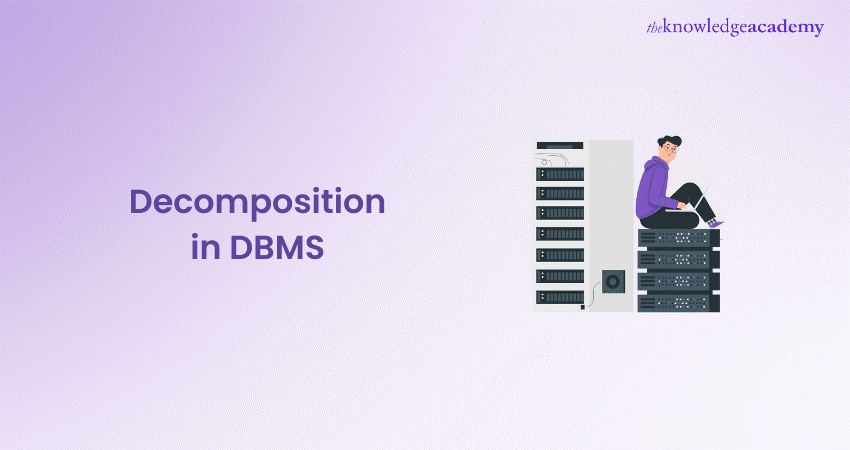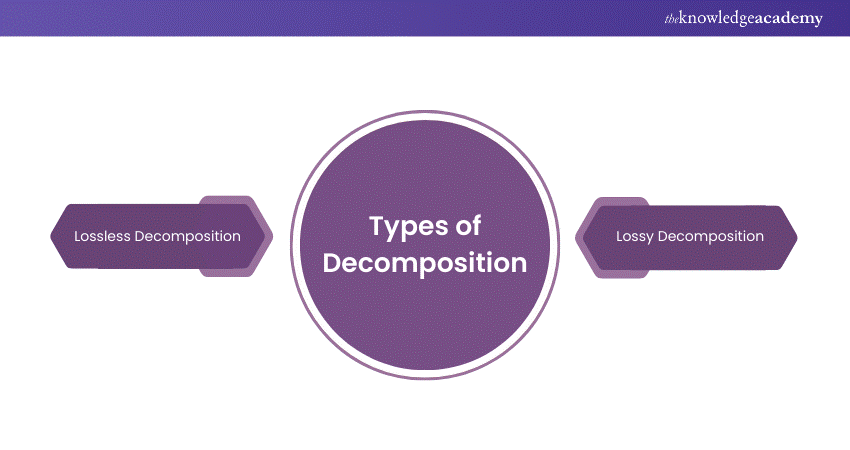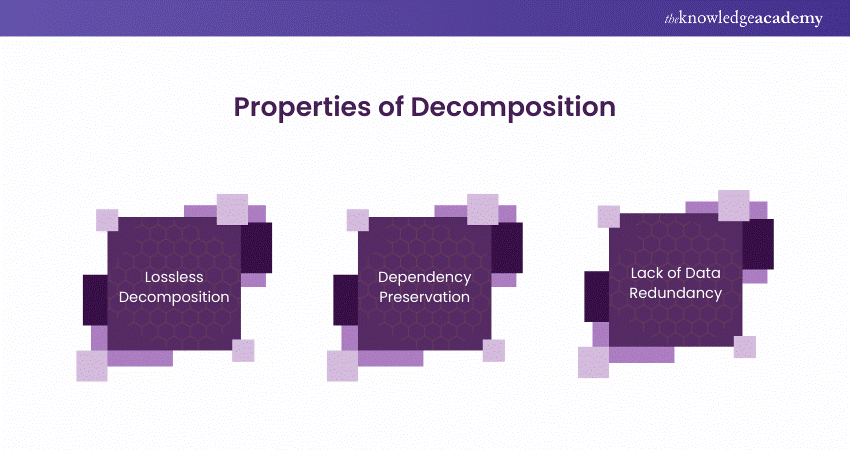We may not have the course you’re looking for. If you enquire or give us a call on +44 1344 203 999 and speak to our training experts, we may still be able to help with your training requirements.
Training Outcomes Within Your Budget!
We ensure quality, budget-alignment, and timely delivery by our expert instructors.

Having trouble with duplicate Data and irregularities in your Database? Try Decomposition in DBMS. Knowing how to properly break down intricate connections is essential for preserving data accuracy and maximising Database efficiency. By becoming adept at Decomposition, you can greatly improve Database normalisation, simplify your data structures, and minimise inconsistencies.
This blog will lead you through the fundamental aspects of Decomposition in DBMS, its main properties, and practical tips to maintain a well-structured and effective Database. Delve into understanding how excelling in Decomposition in DBMS can differentiate you in the Data Management industry!
Table of Contents
1) What is Decomposition in DBMS?
2) Different Types of Decomposition
a) Lossless Decomposition
b) Lossy Decomposition
3) Properties of Decomposition
a) Decomposition Should be Lossless
b) Dependency Preservation
c) Lack of Data Redundancy
3) Conclusion
What is Decomposition in DBMS?
Decomposition in Database Management Systems involves breaking down a complicated Database relation into smaller, more easily handled relations. This method enhances Database normalisation by removing duplicate information and reducing data irregularities. It assures data integrity, simplifying the task of maintaining and updating information in the Database. Decomposition can be done using techniques such as lossless join and dependency preservation, which maintain the consistency and dependencies of the original data.
Decomposition improves query performance and storage efficiency by splitting large tables. It streamlines the entire Database layout, enhancing clarity and ease of use. Nevertheless, incorrect Decomposition may result in data loss or unwarranted intricacy.
Therefore, Database Administrators and Designers need to comprehend the principles of effective Decomposition. When used correctly, it helps maintain a structured, productive, and trustworthy Database system and improves Data Management and Decision-Making procedures.
Different Types of Decomposition
Understanding the various types of Decomposition in DBMS is vital for handling data integrity and optimising Database performance.

1) Lossless Decomposition
Lossless decomposition is a concept primarily used in database management, particularly in the context of relational databases. It refers to the process of decomposing a database relation into two or more smaller relations in such a way that the original relation can be perfectly reconstructed (or recovered) by joining these smaller relations. The key characteristic of lossless decomposition is that no data is lost or duplicated during the process.
In practice, lossless decomposition is used to normalise databases, breaking down complex relations while ensuring that no information is lost and that the join operation on the decomposed relations yields the original dataset without inconsistencies.
Key Characteristics of lossless decomposition:
a) Ensures that data integrity is maintained.
b) Prevents redundancy and anomalies in the database.
c) Essential for maintaining the consistency and accuracy of the database after decomposition.
Lossless decomposition is critical in database design to enhance efficiency, reduce redundancy, and maintain the overall integrity of data.
Start your Database journey here with our Introduction to Database Training – Register now!
2) Lossy Decomposition
Lossy decomposition is the opposite of lossless decomposition and occurs when a database relation is decomposed into two or more smaller relations, but the original relation cannot be perfectly reconstructed by joining these decomposed relations. In this case, some information is lost or misrepresented during the decomposition process.
In relational database management, lossy decomposition can result in data anomalies, redundancy, and inaccuracies when trying to retrieve the original dataset. This type of decomposition is generally avoided in database design, as it can lead to data integrity issues and unreliable results when performing queries or joins on the decomposed relations.
Key Characteristics of lossy decomposition:
a) Information is either lost or cannot be accurately recovered.
b) Joins on decomposed relations may produce extra rows or inaccurate data.
c) It can lead to redundancies and inconsistencies in the database.
Lossy decomposition may arise due to poor database design or when trying to simplify relations without adhering to proper normalisation principles. It is generally discouraged because of the potential risks it poses to data accuracy and integrity.
Properties of Decomposition
Let's explore the properties of Decomposition and see how vital it is in maintaining data integrity, reducing redundancy, and optimising database performance in DBMS.

1) Decomposition Should be Lossless
Decomposition needs to be done in a lossless manner to safeguard all information within the Decomposed relations. This ensures that combining the Decomposed relations accurately recreates the original relation without any data loss.
2) Dependency Preservation
Dependency preservation ensures that at least one Decomposed table meets all dependencies. When {P → Q} is true, the sets exhibit functional dependence. Keeping functional dependencies ensures that dependency checks can be done efficiently without having to compute the natural join of the Database. This feature makes updating easier and ensures Database integrity remains intact.
3) Lack of Data Redundancy
Lack of data redundancy is the absence of unnecessary data duplication in the Database. Negligent Decomposition may result in unnecessary data, impacting the Database's effectiveness. Effective normalisation aids in attaining this characteristic, reducing duplication and upholding data integrity.
Ready to Conquer Redis Clusters? Start with our Redis Cluster Database Training today!
Conclusion
Decomposition in DBMS is crucial for efficient Database normalisation. It breaks complex relations to minimise redundancy and maintain data integrity. Utilising proper decomposition methods can improve Database efficiency and ensure the integrity of well-organised data. We hope you understand how decomposition assists in controlling dependencies and ensuring seamless data integration, thereby increasing your database's efficiency. So, embrace the processes of Decomposition in DBMS to improve your Data Management strategy right now!
Master MySQL basics with ease with our Introduction to MySQL Course – Join now!
Frequently Asked Questions

Effective Decomposition preserves data integrity and minimises duplication, guaranteeing seamless joins. Poor Decomposition results in data loss, duplication, or irregularities, complicating Database management and reliability.

Decomposition in DBMS aims to simplify intricate relations, diminish redundancy, enhance Database normalisation, and maintain data integrity and dependencies.

Decomposition simplifies complex Database relations by dividing them into smaller, more manageable relations. This improves data structure, eliminates redundancy, and boosts Database performance and consistency.

The Knowledge Academy takes global learning to new heights, offering over 30,000 online courses across 490+ locations in 220 countries. This expansive reach ensures accessibility and convenience for learners worldwide.
Alongside our diverse Online Course Catalogue, encompassing 19 major categories, we go the extra mile by providing a plethora of free educational Online Resources like News updates, Blogs, videos, webinars, and interview questions. Tailoring learning experiences further, professionals can maximise value with customisable Course Bundles of TKA.

The Knowledge Academy’s Knowledge Pass, a prepaid voucher, adds another layer of flexibility, allowing course bookings over a 12-month period. Join us on a journey where education knows no bounds.

The Knowledge Academy offers various Database Training, including the Introduction To Database Training, Relational Databases & Data Modelling Training, and GraphQL Database Training With React. These courses cater to different skill levels, providing comprehensive insights into What is Data Modelling.
Our Programming & DevOps Blogs cover a range of topics related to Database, offering valuable resources, best practices, and industry insights. Whether you are a beginner or looking to advance your Database Management skills, The Knowledge Academy's diverse courses and informative blogs have got you covered.
Upcoming Programming & DevOps Resources Batches & Dates
Date
 Introduction to Database Training
Introduction to Database Training
Fri 21st Feb 2025
Fri 25th Apr 2025
Fri 20th Jun 2025
Fri 22nd Aug 2025
Fri 17th Oct 2025
Fri 19th Dec 2025







 Top Rated Course
Top Rated Course



 If you wish to make any changes to your course, please
If you wish to make any changes to your course, please


